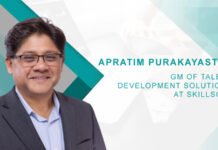Mark, can you tell us about Vistra’s customized, hybrid learning program and how it empowers the workforce to develop critical power skills?
Vistra came to us with a problem plaguing so many organizations. How do you foster learning in the workplace when you have a dispersed workforce? The corporate service provider was interested in building an expansive and engaging culture of learning for its more than 5,000 employees around the world to help prepare for future challenges.
With the help of Skillsoft and our AI-powered learning platform, we created a cutting-edge solution, the Vistra Skills Portal, customized to the organization’s needs. The team crafted an array of digital, virtual instructor-led, blended, and in-person learning programs to engage the business and its colleagues and help employees gain new skills and apply them in the real world. But that was just the beginning – by partnering with leaders and working groups across the business, Vistra used global engagement sessions to showcase the Skills Portal to learners. Leaders continued collaborating with the team to create tailored learning programs targeting their colleagues’ unique needs and projects.
Through their efforts, the team fueled the massive adoption of the custom learning platform. They keep engagement high by regularly refreshing content and promoting topical learning sessions that address big-picture questions and concerns, like sustainability and how to leverage big data. Since implementing this new training, the total number of training course pageviews has skyrocketed by 368 percent, course browsing hours have increased by 372 percent, and learning hours by 586 percent.
In the current rapidly transforming business landscape, why is there an urgent need for skill-building among employees?
The business landscape is rapidly transforming – especially in light of recent disruptive innovations like generative AI. Meanwhile, workforce reductions, a shrinking talent pool, and growing skills gaps are forcing employees to shoulder more responsibilities – sometimes tasked with new challenges they aren’t yet prepared for. As this trend persists, learning and training become even more urgent. Developing broad and deep skill sets is essential. Traditionally characterized as the “T-shaped” employee, a workforce’s ability to seamlessly transition between different projects requires it to possess a diversified skill set.
Establishing a culture that encourages T-shaped employees who are well-versed in power and hard skills benefits both employers and employees alike. Employers can transform their organization into one built on adaptability and agility while also empowering employees to be more efficient at work and take on new opportunities aligned with gained competencies.
How does an L&D program like Vistra’s address the challenges faced by companies struggling to retain and attract top talent during a paradoxical talent-constrained, knowledge-worker recession?
Workforce skill-development programs increased in importance after the great resignation left skills and talent gaps across a range of industries. According to Pew Research, over half of employed U.S. adults (53%) who quit their job changed industries and careers leaving a skills gap in their wake. It’s no surprise that employees are keenly interested in learning; a lack of skills development and career progression stands out as a significant driver of turnover. Today’s workforce is seeking challenges, opportunities to tackle stretch assignments, and avenues for advancement in their professional journey.
It’s important to note that career advancement doesn’t always equate to moving into management positions. Each individual has their own path, and the ever-changing technology landscape and emerging business models, have created a broad range of paths to career fulfillment. By providing upskilling opportunities, companies can offer employees the learning experiences they crave while simultaneously building an internal talent pipeline aligned with business needs and employee desires.
Could you share some insights on the human skills, or “power skills”, that are important to develop within the workforce?
Emphasizing the development of power skills has become increasingly critical. According to our Lean Into Learning Report, Business & Leadership learning hours on Skillsoft’s platform have risen by an impressive 32% compared to last year, indicating the significance of power skills. We found written communication, unconscious bias, and adapting to virtual work as some of the top power skills to possess.
At Skillsoft, we actively foster the growth and upskilling of power skills through coaching and other programs. Successful organizations and workforces enable a culture of learning that strikes a harmonious balance between power skills and hard skills. Being well-rounded has never been more important. Possessing hard skills while also leading with compassion and authenticity is critical to success. With disruptive technologies like generative AI, there must be a higher priority behind power skills like critical thinking, innovation, empathy, resilience, effective communication, and adaptability to prepare for and embrace the next big thing. As the future of work continues to change, a workforce that is agile and able to adapt is a competitive and successful one.
What are the key factors that contributed to the significant increase in hours spent learning (586% YoY increase) within Vistra’s workforce after implementing the L&D program?
Vistra saw such a dramatic increase in its learning largely in part due to effective communication. In order to engage and enable its employees to learn, Vistra put an emphasis on how experiences like this were communicated amongst employees around the world. Just as important, Vistra built a custom, personalized content for learners, beginning with a new strategically important leadership development program called Leadership Essentials, which utilized Skillsoft. This approach was targeted at new, existing, and aspiring people managers and leaders who wanted to refresh their core leadership skills. By forgoing a “one size fits all” approach, courses like Leadership Essentials were an immediate success, attracting a wave of new learners to the Vistra Skills Portal.
What were some of the initial challenges or obstacles faced during the implementation of the hybrid learning program, and how were they overcome?
Vistra’s employees were interested in professional development, but as with a lot of organizations that look to implement a culture of learning, there were several obstacles to overcome. Prior to implementing this new platform, monthly learning hours typically hovered around 10 hours a month or lower, so increasing engagement, awareness, and enablement was a top priority.
Through engagement, Vistra employees were able to understand the learning opportunities open to them. To ensure learners, That wasn’t the only thing that was important – engagement was the first step followed by building awareness so that learners fully understood how they could learn at Vistra and reach their goals and unleash their true potential. To promote continued learning, we enabled a platform that tracked training and delivered business learning projects.
How can a hybrid approach to learning (combining online and in-person elements) benefit a workforce and the overall learning experience? Is there a one size fits all approach or is it dependent on the organization?
No two organizations will demand the same learning experience. In the case of Vistra, we met them where they needed us, building a platform that was unique to their needs that could take on the challenge of enabling a culture of learning at a global, hybrid scale. That is why it is critical to align learning programs and modalities with the needs and goals of the learner, as well as the broader organization.
Before deciding what learning solution is best, leaders must take stock of what skills their employees already have and where gaps exist. In doing so, they will be able to determine the most appropriate learning paths. You can’t leave skilling up to chance. You’ll also need to build a metric for success and regularly assess and benchmark skills, adjust learning priorities and goals amidst emerging business changes (like generative AI). It’s all about building the lead indicators of effectiveness and adapting programs to ensure employees fulfill their professional aspirations and the business meets its objectives. Business leaders must also dedicate equal efforts to communicating learning opportunities as they do in constructing the learning programs themselves.
In your experience, what are some common barriers or resistance that companies face when implementing a comprehensive L&D program, and how can they be overcome?
There are several barriers organizations may face. A lack of management commitment and buy-in, a common barrier, leads to apathy and disengagement from the workforce. When enabling learning, there must be a clear alignment with the business. If organizations develop learning, for the sake of learning, it generally results in lukewarm adoption and questionable ROI. For all of the discussion around ROI, most ROI issues are a function of the initial success measures that were or were not, defined.
Lastly, there must be a clear value proposition (“What’s in it for me” aka WIIFM) to the workforce and alignment with their career goals. If the workforce doesn’t see the long-term value in what they’re learning, it’s highly unlikely that they’ll put the time in. This is why we put emphasis on credentialing and badging. In almost all cases, earning a credential or badge from a course will increase adoption and completion rate because you’re giving the learner something tangible
What advice or recommendations do you have for other organizations looking to implement a successful and impactful learning and development program?
When addressing organizational challenges, it is crucial to have a clear goal in mind. Before enabling an L&D program, define the specific business problem that you aim to solve through learning. That way, you are able to learn whether learning is indeed the appropriate solution for this problem. If an L&D program is suitable, determine the metrics and criteria you will use to measure success. It’ll be important to involve executives and managers in the significance of these measures and their belief in learning as a means to address the problem. That’s not all; ensure leaders are actively involved in the process including setting clear expectations of them.
With leaders involved, you’ll need to craft a compelling value proposition for learners, highlighting the benefits of investing their time in learning rather than solely focusing on immediate deliverables. Consider the rewards and incentives that can motivate their engagement. Establish metrics for learners to gauge their own success. Provide guidance to help them choose the most suitable programs and determine the logical progression for their learning journey. Consider implementing opportunities to acknowledge and appreciate learners who make a commitment to their development.
Looking ahead, what trends or developments do you foresee in the field of L&D that will shape the way companies approach employee skill-building in the coming years?
Skill building must be a priority for all leaders. How and where we learn looks different, especially as remote and hybrid work models become permanent fixtures. Location isn’t the only challenge for business leaders – acute disruption from AI and emerging requirements for sustainability will further disrupt the global workforce and will create “skill bubbles” that will need to be solved.
Furthermore, the influx of AI tools will also create opportunities and challenges for businesses and the workforce alike. Leaders will need to employ empathy during these transformative times, and individual contributors will need to re-learn their jobs or change jobs altogether. While this seems very daunting, my sense is that it will yield a new era of prosperity and growth, provided that both businesses and the workforce are able to adapt and learn new skills, such as prompt engineering, LLM, machine learning, and the like.
This new frontier of AI will likely spur a rise in “versatilists” – employees wearing multiple technical and non-technical hats – as we see the need for the workforce to have both world-class tech skills and strong interpersonal “power” skills, like mindful communication, awareness of bias, and the ability to give and receive feedback. It’s never been more important to ensure workforces feel confident and ready to take on tomorrow’s challenges, today.
Discover the full potential of your Hrtech strategy with our comprehensive Hrtech News and Hrtech Interviews.
Want to Contribute? CLICK HERE To Submit Your Guest Post and Join Our Community of Writers!!!

Mark Onisk Chief Content Officer at Skillsoft
Since becoming Chief Content Officer in 2018, Mark has been responsible for leading all aspects of Skillsoft’s content catalog, including strategic direction, roadmap and development.
Mark previously served SVP of Skillsoft Books, successfully launching the company’s book summary product, increasing the audiobook collection by more than 60% and creating the largest collection of audiobooks in the corporate learning market. Prior to Skillsoft Books, Mark led Skillsoft’s strategic business development, where he worked on cross-functional projects and services teams to deliver integrated learning experiences with key clients.
Mark became Skillsoft’s VP, Content Production after the company acquired Element K in 2011. His career with Element K spanned 15 years, where he was responsible for product strategy, content development and operational execution. Mark holds an MBA from the Rochester Institute of Technology and Bachelors of Science in Finance and Economics from State University of New York, College at Brockport.












